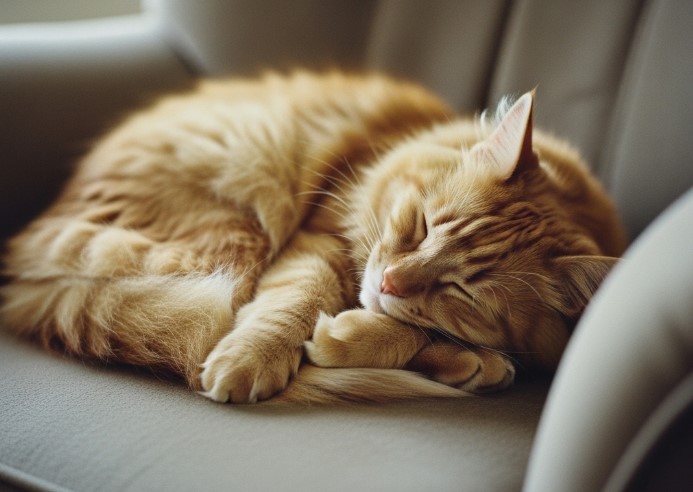You’ve probably seen it before: your cat curled up on the sofa, eyes shut, paws twitching, whiskers quivering. Sometimes they make little sounds—chirps, squeaks, or even meows—while deep in slumber. It’s enough to make you ask:
Do cats dream while sleeping?
The answer, according to science, is: Yes, they do!
Cats may not tell us what they dream about, but their brains behave much like ours during sleep. In fact, the more we learn about feline sleep patterns, the more it appears that cats experience dreams, emotions, and memories—just like people do.
Let’s dive into the fascinating world of cat dreams: how sleep works in cats, how you can tell they’re dreaming, and what they might actually be dreaming about.
1. How Do Cats Sleep?
Before we explore dreams, let’s understand how cats sleep—because their sleep patterns are different from ours in a few important ways.
💤 Cats Sleep a Lot
On average, cats sleep 12 to 16 hours per day, and kittens or senior cats can sleep up to 20 hours! That’s more than half their lives.
This isn’t laziness—it’s evolution. As predators, cats expend lots of energy when hunting, so nature designed them to recover and conserve energy through long naps.
🧠 Two Main Sleep Phases
Like humans, cats experience two primary types of sleep:
1. Non-REM (Light/Deep Sleep)
- The body repairs itself
- Heart rate and breathing slow down
- Lasts 15–30 minutes per cycle
2. REM (Rapid Eye Movement) Sleep
- This is when dreaming happens
- The brain becomes highly active
- The eyes move under closed lids
- Muscles may twitch or spasm
Cats experience REM sleep in short but frequent bursts, especially during deep sleep cycles that occur several times per day.
2. Do Cats Actually Dream?
✅ Yes—Science Says So
Research shows that most mammals dream, and cats are no exception.
In 1965, French neuroscientist Michel Jouvet conducted groundbreaking studies on REM sleep in cats. He discovered that when the part of the cat’s brain responsible for muscle inhibition was disabled during REM sleep, cats would start to act out their dreams: swatting, stalking, or even leaping in their sleep. This provided strong evidence that cats were mentally reliving past experiences—or dreaming.
Later studies using brain scans have confirmed that cats experience brain activity during REM sleep that closely resembles waking cognition.
3. What Do Cats Dream About?
While we can’t ask them directly (yet!), scientists believe cats probably dream about:
🐭 Hunting Behavior
- Chasing mice, birds, or toys
- Stalking prey
- Practicing attack strategies
🧍 Human Interaction
- Being petted
- Cuddling or being groomed
- Playing with their owners
🐱 Other Cats and Animals
- Encounters with other pets in the home
- Memories of kittens or littermates
- Past conflicts or affection
In short: cats likely dream about their day—just like humans. They might replay exciting, emotional, or stressful moments from their waking life.
4. How Can You Tell If Your Cat Is Dreaming?
Here are signs your cat might be in a dream state during REM sleep:
👀 Eye Movement
You may notice your cat’s eyes moving under their eyelids—classic REM behavior.
🐾 Twitching Paws or Whiskers
Tiny movements in the paws, tail, or whiskers often mean dream-driven brain activity.
😺 Vocalizations
Soft meows, chirps, or purring can occur during dreams, especially in kittens and seniors.
💤 Sudden Tail Flicks or Body Jerks
These movements may be your cat “acting out” a dream, such as pouncing or running.
Just like humans who flinch or mumble in their sleep, cats are physically responding to whatever scenes play out in their minds.
5. Do Cats Have Nightmares?
Possibly—yes.
Because cats can form emotional memories, it’s believed they are also capable of having bad dreams or nightmares, especially if:
- They’ve experienced trauma
- They’re stressed or anxious
- They’ve been recently ill or injured
Signs of a nightmare may include:
- Sudden waking
- Hissing or growling in sleep
- Dilated pupils or running upon waking
If your cat seems distressed after sleeping, don’t worry too much—it’s usually short-lived. But it’s a good idea to ensure their environment is calm, secure, and positive.
6. Do Kittens Dream More?
Yes! Just like human babies, kittens spend a larger percentage of sleep time in REM. That’s because their brains are still developing and processing massive amounts of new information.
Kittens may dream about:
- Learning to walk and run
- Interacting with their mother and siblings
- New sights, sounds, and smells
You might see kittens twitching constantly while sleeping—it’s completely normal and part of their growing minds in action.
7. Can You Wake a Dreaming Cat?
It’s best to let sleeping cats lie—especially during REM sleep.
Sudden awakening from a deep dream state can:
- Disorient or startle your cat
- Trigger aggression or fear
- Disrupt their natural sleep cycle
If you must wake them, do it gently—use soft sounds rather than touching them abruptly.
Conclusion: Yes, Cats Do Dream—And It’s Adorable
Cats don’t just sleep a lot—they experience vivid, active dreams much like we do. Whether they’re chasing imaginary prey, reliving a playful moment with their human, or simply processing a new sound, their dreaming brains are just as busy as ours.
The next time you see your cat twitch, chirp, or smile in their sleep, rest assured—they’re likely dreaming away in their own mysterious world.
Want to understand more about your cat’s behavior?
Subscribe to our newsletter for weekly feline facts, health tips, and fun behind-the-scenes insights into your cat’s secret life!

